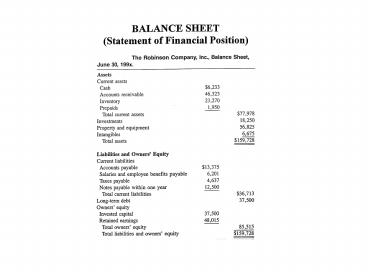Assets on the Balance Sheet - PowerPoint PPT Presentation
Title:
Assets on the Balance Sheet
Description:
Assets on the Balance Sheet Current Assets are used up , expended or converted into cash within 12 months Some expenses are Prepaid in advance. – PowerPoint PPT presentation
Number of Views:126
Avg rating:3.0/5.0
Title: Assets on the Balance Sheet
1
(No Transcript)
2
Assets on the Balance Sheet
- Current Assets are used up, expended or
converted into cash within 12 months - Some expenses are Prepaid in advance. These
become an ASSET
3
Assets on the Balance Sheet
- Non-current Assets are used up or expended in
a period longer than 12 months - Non-current Assets do not have a category title,
they are just listed after Current Assets
4
Liabilities on the Balance Sheet
- Current Liabilities are discharged or paid
off within 12 months.
5
Owners Equity on the Balance Sheet
- Owners Equity is the difference between Assets
and Liabilities. - The value remaining in the company for the
owners. - Not a pool of cash
- Revenues increase Owners Equity Expenses
decrease it. - Invested Capital Voluntary investment of funds
- Retained Earnings residual value from
profit-seeking activities - Retained Earnings help the business to grow
6
(No Transcript)
7
Double-entry Bookkeeping
- Newton Third Law of Motion
- For every action there is an equal and opposite
reaction - Accounting rules
- For every Debit there is an equal and opposite
Credit recorded in the accounting records
8
Double-entry Bookkeeping
- Double-entry bookkeeping is the accepted
accounting mechanism for recording and
classifying the monetary events of a business
entity - The T-account format
- For every monetary event there is at least one
entry on the debit side of at least one account
and the credit side of another account.
9
Double-entry Bookkeeping
- A L OE
Account Type Debit Effect Credit Effect
Assets Increase Decrease
Liabilities Decrease Increase
Owners Equity Decrease Increase
10
The Journal
11
Chart of Accounts
12
The Ledger
13
The Cycle at Work






























